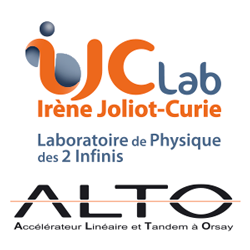 LICORNE directional neutrons are produced using inverse reactions of heavy ions on hydrogen (protons). The prinicpal heavy ion used is an intense 7Li beam from the tandem accelerator of the IPN Orsay hitting a hydrogen-rich target. The principle nuclear reaction that occurs is p(7Li,n)7Be at energies of between 13 MeV and 17 MeV, which produces neutrons travelling with a velcoity similar to that of the centre of mass with energies of between 0.5 MeV and 4 MeV. High neutron fluxes are acheived due to the kinematic focussing where enhancement factors are typically a factor of 30 over conventional isotropic neutron sources since the neutrons emitted isotropically in the centre of mass frame end up highlf forward focussed in the laboratory frame. This natural directionality of LICORNE ensures that the source is very low background, with minimal scattering from the walls of the experimental hall.
LICORNE directional neutrons are produced using inverse reactions of heavy ions on hydrogen (protons). The prinicpal heavy ion used is an intense 7Li beam from the tandem accelerator of the IPN Orsay hitting a hydrogen-rich target. The principle nuclear reaction that occurs is p(7Li,n)7Be at energies of between 13 MeV and 17 MeV, which produces neutrons travelling with a velcoity similar to that of the centre of mass with energies of between 0.5 MeV and 4 MeV. High neutron fluxes are acheived due to the kinematic focussing where enhancement factors are typically a factor of 30 over conventional isotropic neutron sources since the neutrons emitted isotropically in the centre of mass frame end up highlf forward focussed in the laboratory frame. This natural directionality of LICORNE ensures that the source is very low background, with minimal scattering from the walls of the experimental hall.The kinematic curves of the p(7Li,n)7Be reaction are shown here, demonstrating how the neutron energies in the laboratory frame vary as a function of their angle of emission for different 7Li bombarding energies.
LICORNE functions with both thin (4um) and thick (30um) polypropylene discs which produce both quasi-monoenergetic neutron spectra and white neutron spectra, respectively.
EXTENSION OF THE LICORNE ENERGY RANGE UP TO 12 MEV
In the future, we plan to extend the LICORNE neutron production energy range up to around 12 MeV, using the p(11B,n)11C reaction. The ALTO tandem accelerator can also produce intense beams of 11B and this will help enhance LICORNE’s capabilities.
 The kinematic curves for the p(11B,n)11C reaction are shown here. This reaction will be used for the first time to test the neutron response of the PARIS cluster detectors, one of the physics applications in the LICORNE physics program.
The kinematic curves for the p(11B,n)11C reaction are shown here. This reaction will be used for the first time to test the neutron response of the PARIS cluster detectors, one of the physics applications in the LICORNE physics program.











